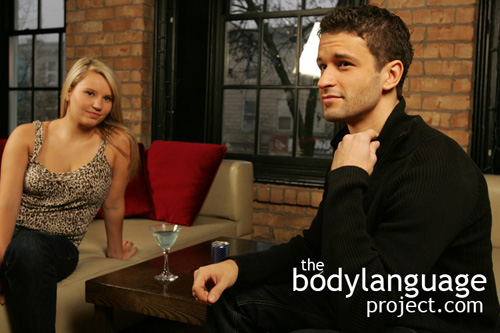Body Language of Hands In Pockets
Synonym(s): N/A
Description: When the hands are placed in the pockets.
In One Sentence: Having the hands in the pockets signals lack of confidence, overexposure, and the need for privacy.
How To Use it: Hiding the hands in the pockets can be used to create additional security when you feel uncomfortable. This is useful in front of large audiences. Jamming the hands in the pockets can provide them a safe place to hide which is especially welcome when feeling awkward.
That being said, it’s generally not advised to hold the hands in the pockets, but rather work on ways to be assertive enough to keep hands exposed despite feeling uncomfortable. The hands in pockets are often read as a negative posture.
Context: General.
Verbal Translation: “I’m thankful to have pockets because I’m insecure and really need to put my hands someplace lest I feel even more awkward.”
Variant: Hands are sometimes sat on so they are neatly tucked out of the way.
Cue In Action: Before presenting to the audience, the candidate stood left of stage with his hands in his pockets. A more presidential posture would have included hands to his sides.
Meaning and/or Motivation: A comfort and informal position, but also one that reveals insecurity and a lack of confidence and in more extreme cases even secretiveness as if a person has something to hide.
It is a convenient place to put hands that might otherwise need to find purpose when in awkward situations. Hiding the hands generally is seen as dishonest because the hands carry so much information. For example, the palms of the hands are flashed at a distance, a wave, to prove to others that we carry no weapon. At least this is its theorized origin. Hands that are shaking with fear or sweating from nervousness are often stuffed into pockets to be hidden from critical eyes.
Thus, when hands are jammed into pockets we subconsciously fear and worry that they might be carry something that might harm us. One thing is for certain, if we get pulled over by the police, the last place you should put your hands is in the pockets – keep them high where they can be seen!
Cue Cluster: Hands in pockets is not usually coupled by much else because they usually provide enough security that nothing additional is required. If someone is particularly awkward they might blush or bring their hands out of their pockets to pat the back of their head or neck or smooth their pants to dry them of their sweat. A person might also play with their cufflink or sleeve – a masked arm cross. The head may be bowed during extreme discomfort.
Body Language Category: Closed body language, Defensive, Low confidence body language, Low confidence hand displays, Lying or deceptive body language, Nervous body language.
Resources:
Alibali, M.W., Heath, D.C., and Myers,H.J. (2001). Effects of visibility between speaker and listener on gesture production: Some gestures are meant to be seen. Journal of Memory and Language, 44, 169–188.
Andric, Michael ; Solodkin, Ana ; Buccino, Giovanni ; Goldin-Meadow, Susan ; Rizzolatti, Giacomo ; Small, Steven L. Brain function overlaps when people observe emblems, speech, and grasping. Neuropsychologia, 2013, Vol.51(8), pp.1619-1629
Alibali, M.W., Heath, D.C., and Myers,H.J. (2001). Effects of visibility between speaker and listener on gesture production: Some gestures are meant to be seen. Journal of Memory and Language, 44, 169–188.
Beattie, G., & Shovelton,H.(1999). Mapping the range of information contained in the iconich and gestures that accompany spontaneous speech. Journal of Language and social Psychology, 18, 438–462.
Biau, E., & Soto-Faraco, S.(2013). Beat gestures modulate auditory integration in speech perception. Brain and Language, 124(2), 143–152.
Bartolo, A.,Cubelli,R.,DellaSala,S.,&Drei,S.(2003).Pantomimes are special gestures which rely on working memory. Brain and Cognition, 53, 483–494.
Bernardis, P.,& Gentilucci,M.(2006).Speech hand gestures are the same communication system. Neuropsychologia, 44, 178–190.
Buccino, G.,Vogt,S., Ritzl, A., Fink, G .R., Zilles, K., Freund, H. J., et al.(2004).Neural circuits underlying imitation learning of hand actions: Anevent-related fMRI study. Neuron, 42, 323–334.
Balzarotti, Stefania ; Piccini, Luca ; Andreoni, Giuseppe ; Ciceri, Rita “I Know That You Know How I Feel”: Behavioral and Physiological Signals Demonstrate Emotional Attunement While Interacting with a Computer Simulating Emotional Intelligence. Journal of Nonverbal Behavior. 2014. 38(3): 283-299.
Bernstein, Constance. Winning trials nonverbally: six ways to establish control in the courtroom. Trial. 1994. 30(1).61(5)
Brownell, Judi. Communicating with credibility: The gender gap. Cornell Hotel and Restaurant Administration Quarterly. 1993. 34(2): 52-61.
Sharpley, Christopher F ; Halat, Jennifer ; Rabinowicz, Tammy ; Weiland, Birgit ; Stafford, Jane. Standard posture, postural mirroring and client-perceived rapport. Counselling Psychology Quarterly. 2001. 14(4): 267-280.
Cuddy, Amy J.C. ; Glick, Peter ; Beninger, Anna. The dynamics of warmth and competence judgments, and their outcomes in organizations. Research in Organizational Behavior. 2011. 31: 73-98.
Dick, A.S., Goldin-Meadow,S., Hasson,U.,Skipper, J.I., & Small, S.L. (2009). Co- speech gestures influence neural activity in brain regions associated with processing semantic information. Human Brain Mapping, 30, 3509–3526.
Desteno, David ; Breazeal, Cynthia ; Frank, Robert H ; Pizarro, David ; Baumann, Jolie ; Dickens, Leah ; Lee, Jin Joo. Detecting the Trustworthiness of Novel Partners in Economic Exchange. Psychological Science. 2012. 23(12): 1549-1556.
Edinger, Joyce A. ; Patterson, Miles L. Zeaman, David (editor). Nonverbal involvement and social control. Psychological Bulletin. 1983. 93(1): 30-56.
Fatt, James P. T. It’s not what you say, it’s how you say it.(nonverbal communication). Communication World. 1999. 16(6): 37(4).
Fabbri-Destro, M.,& Rizzolatti,G. (2008). Mirror neurons and mirror systems in monkeys and humans. Physiology, 23, 171–179.
Fogassi, L., Gallese,V., Fadiga,L., & Rizzolatti,G. (1998). Neurons responding to the sight of goal directed hand/armactions in the parietal area PF (7b) of the macaque monkey. Society for Neuroscience, 24, 257.5.
Fusaro, M., Harris, P. L., & Pan, B. A. (2012). Head nodding and head shaking gestures in children’s early communication. First Language, 32, 439–458. doi:10.1177/0142723711419326
Gentilucci, M., Bernardis, P., Crisi,G., & Dalla Volta, R. (2006). Repetitive transcranial magnetic stimulation of Broca’s area affects verbal responses to gesture observation. Journal of Cognitive Neuroscience, 18, 1059–1074.
Goldin-Meadow, S. (1999).The role of gesture in communication and thinking. Trends in Cognitive Sciences, 3, 419–429.
Goldin-Meadow, S.(2003). Hearing gesture: How our hands help us think. Cam-bridge, MA: Belknap Press of Harvard University Press.
Gräfenhain, M., Behne, T., Carpenter, M., & Tomasello, M. (2009). One-year-olds’ understanding of nonverbal gestures directed to a third person. Cognitive Development, 24, 23–33. doi:10.1016/j.cogdev.2008.10.001
Guidetti, M. (2005). Yes or no? How do young children combine gestures and words to agree and refuse. Journal of Child Language, 32, 911–924. doi:10.1017/S0305000905007038
Gorkan Ahmetoglu, Viren Swami. Do Women Prefer “Nice Guys?” The Effect Of Male Dominance Behavior On Women’s Ratings. Social Behavior And Personality, 2012; 40(4), 667-672.
http://bodylanguageproject.com/articles/how-to-significantly-increase-male-attractiveness-with-simple-body-language-nice-guys-finish-last-once-again/
Hummer, P., Wimmer, H., & Antes, G. (1993). On the origins of denial negation. Journal of Child Language, 20, 607– 618. doi:10.1017/S0305000900008503
Hubbard, A.L., Wilson,S.M., Callan,D.E., & Dapretto, M.(2009). Giving speech a hand: Gesture modulates activity in auditory cortex during speech perception. Human Brain Mapping, 30, 1028–1037.
He, Yifei ; Gebhardt, Helge ; Steines, Miriam ; Sammer, Gebhard ; Kircher, Tilo ; Nagels, Arne ; Straube, Benjamin. The EEG and fMRI signatures of neural integration: An investigation of meaningful gestures and corresponding speech. Neuropsychologia.. 2015. 72: 27-42.
Hansen, Jacqueline. Teaching without talking: teachers need to be aware of more than just the words they speak to children. They also need to monitor the nonverbal messages that they’re sending to students through proximity, eye contact, gestures, and touching. Phi Delta Kappan. 2010. 92(1): 35(6).
Holle, H., & Gunter,T.C. (2007). The role of iconic gestures in speech disambiguation: ERP evidence. Journal of Cognitive Neuroscience, 19, 1175–1192.
Holler, J., Shovelton, H.,& Beattie, G.(2009).Do iconic hand gestures really contribute to the communication of semantic information in a face-to-face context? Journal of Nonverbal Behavior, 33, 73–88.
Hubbard, A.L., Wilson, S. M., Callan, D. E., & Dapretto, M.(2009).Giving speech a hand: Gesture modulates activity in auditory cortex during speech perception. Human Brain Mapping, 30, 1028–1037.
Hall, Jeffrey A. and Chong Xing. The Verbal and Nonverbal Correlates of the Five Flirting Styles. Journal of Nonverbal Behavior. 2015. 39:41–68. DOI 10.1007/s10919-014-0199-8
http://bodylanguageproject.com/articles/first-12-minutes-flirting-using-nonverbal-communication-study-reveals-26-body-language-cues-attraction/
Koppensteiner, Markus ; Grammer, Karl. Body movements of male and female speakers and their influence on perceptions of personality. Personality and Individual Differences. 2011. 51(6): 743-747.
Koppensteiner, Markus ; Stephan, Pia ; Jäschke, Johannes Paul Michael. From body motion to cheers: Speakers’ body movements as predictors of applause. Personality and Individual Differences. 2015. 74: 182-185.
Krauss, R. M., Dushay, R.A., Chen,Y., & Rauscher, F.(1995).The communicative value of conversational hand gesture. Journal of Experimental Social Psychology, 31(6), 533–552.
Kendon,A.(1994).Do gestures communicate? A review. Research on Language and Social Interaction, 27, 175–200.
Knutson, K.M., McClellan,E.M., & Grafman, J.(2008).Observing social gestures: An fMRI study. Experimental Brain Research, 188, 187–198.
Kelly, S. D., Barr, D. J., Church, R. B., & Lynch, K.(1999).Offering a hand topragmatic understanding: The role of speech and gesture in comprehension and memory. Journal of Memory and Language, 40, 577–592.
Kelly, S. D., Creigh, P., & Bartolotti, J.(2009).Integrating speech and iconic gestures in a Stroop-like task: Evidence for automatic processing. Journal of Cognitive Neuroscience, 22, 683–694.
Kelly, S.D., Kravitz, C.,& Hopkins, M.(2004).Neural correlates of bimodal speech and gesture comprehension. Brain and Language, 89(1), 253–260.
Krahmer,E., & Swerts, M.(2007).The effects of visual beats on prosodic prominence: Acoustic analyses, auditory perception and visual perception. Journal of Memory and Language, 57, 396–414.
Krauss, R. M., Dushay, R.A., Chen,Y., & Rauscher, F.(1995).The communicative value of conversational hand gesture. Journal of Experimental Social Psychology, 31(6), 533–552.
Leonard, T., & Cummins, F.(2010).The temporal relation between beat gestures and speech. Language and Cognitive Processes, 26, 1457–1471.
Lindenberg, R., Uhlig,M., Scherfeld,D., Schlaug,G., & Seitz, R.J.(2012).Commu- nication with emblematic gestures: Shared and distinct neural correlates of expression and reception. Human Brain Mapping, 33, 812–823.
Leigh, Thomas W. ; Summers, John O. An initial evaluation of industrial buyers’ impressions of salespersons’ nonverbal cues. Journal of Personal Selling & Sales Management. 2002. 22(1): 41(13).
Lee Ann Renninger, T. Joel Wade, Karl Grammer. Getting that female glance: Patterns and consequences of male nonverbal behavior in courtship contexts. Evolution and Human Behavior. 2004; 25: 416–431.
http://bodylanguageproject.com/articles/part-i-how-to-read-male-sexual-body-language-a-study-for-women-and-the-men-who-wish-to-cheat-the-system/
Moore, Monica. Courtship Signaling and Adolescents: Girls Just Wanna Have Fun. Journal of Sex Research. 1995. 32(4): 319-328.
http://bodylanguageproject.com/articles/girls-just-want-to-have-fun-the-origins-of-courtship-cues-in-girls-and-women/
Martens, Jason P.; Jessica L. Tracy and Azim F. Shariff. Status signals: Adaptive
benefits of displaying and observing the nonverbal expressions of pride and shame, Cognition & Emotion. 2012. 26(3): 390-406. DOI: 10.1080/02699931.2011.645281
http://bodylanguageproject.com/articles/significant-nonverbal-expression-pride-shame-body-language-detailed-examination-origin-function/
Mehrabian, Albert ; Williams, Martin Mcguire, William J. (editor). Nonverbal concomitants of perceived and intended persuasiveness. Journal of Personality and Social Psychology. 1969. 13(1): 37-58.
Montgomery, K.J., Isenberg, N., & Haxby,J.V. (2007). Communicative hand gestures and object-directed hand movements activated the mirror neuron system. Social Cognitive and Affective Neuroscience, 2, 114–122.
Molnar-Szakacs, Istvan ; Wu, Allan D ; Robles, Francisco J ; Iacoboni, Marco Robertson, Edwin (Academic Editor). Do You See What I Mean? Corticospinal Excitability During Observation of Culture-Specific Gestures (Gesture Perception). PLoS ONE. 2007. 2(7): p.e626
Parzuchowski, Michal and Bogdan Wojciszke. Hand Over Heart Primes Moral Judgments and Behavior. Journal of Nonverbal Behavior, 2014; 38:145–165.
http://bodylanguageproject.com/articles/hand-over-heart-primes-moral-judgments-and-behavior/
Ohgami, Y., Matsuo,K., Uchida,N., & Nakai,T. (2004). An fMRI study of tool-use gestures: Body partas object and pantomime. Neuroreport, 15, 1903–1906.
Pease, Barbara and Allan Pease. 2006. The Definitive Book of Body Language Hardcover. Bantam
Roll, William V. ; Schmidt, Lyle D. ; Kaul, Theodore J. Berdie, Ralph F. (editor). Perceived interviewer trustworthiness among black and white convicts. Journal of Counseling Psychology. 1972. 19(6): 537-541.
Ryan, Mary E. Good nonverbal communication skills can reduce stress. (Law Office Management). Trial. 1995. 31(1): 70(5).
Sturman, Edward D. Invluntary Subordination and Its Relation to Personality, Mood,
and Submissive Behavior. Psychological Assessment. 2011. 23(1): 262-276 DOI: 10.1037/a0021499
http://bodylanguageproject.com/articles/nonverbal-submission-men-women-depression-critical-examination-use-disuse-submission/
Skipper, J.I., Goldin-Meadow, S., Nusbaum,H.C.,& Small,S.L. (2007).Speech- associated gestures, Broca’s area, and the human mirror system. Brain and Language, 101, 260–277.
Sherzer, Joel The Brazilian Thumbs-Up Gesture. Journal of Linguistic Anthropology, 1991, Vol.1(2), pp.189-197
Straube,B., Green,A., Bromberger,B., & Kircher, T. (2011).The differentiation of iconic and metaphoric gestures: Common and unique integration processes. Human Brain Mapping, 32, 520–533.
Straube, Benjamin ; Green, Antonia ; Jansen, Andreas ; Chatterjee, Anjan ; Kircher, Tilo. Social cues, mentalizing and the neural processing of speech accompanied by gestures. Neuropsychologia. 2010. 48(2): 382-393.
Sharpley, Christopher F ; Halat, Jennifer ; Rabinowicz, Tammy ; Weiland, Birgit ; Stafford, Jane. Standard posture, postural mirroring and client-perceived rapport. Counselling Psychology Quarterly. 2001. 14(4): 267-280.
Tam, C. W., & Stokes, S. F. (2001). Form and function of negation in early developmental Cantonese. Journal of Child Language, 28, 373–391. doi:10.1017/S0305000901004688
Villarreal, M., Fridman,E.A., Amengual,A., Falasco,G., Gerscovich,E.R., Ulloa,E.R., et al. (2008). The neural substrate of gesture recognition. Neuropsychologia, 46, 2371–2382.
Vaidyanathan, R. (1991). Development of forms and functions of negation in the early. tages of language acquisition: A study in Tamil. Journal of Child Language, 18, 51–66. doi:10.1017/S0305000900013295
Willems, R.M., Ozyurek,A., & Hagoort,P.(2007).When language meets action:The neural integration of gesture and speech. CerebralCortex, 17, 2322–2333.
Wieser, Matthias J.; Tobias Flaisch and Paul Pauli. Raised Middle-Finger: Electrocortical Correlates of Social Conditioning with Nonverbal Affective Gestures. 2014. PLoS ONE 9(7): e102937. doi:10.1371/journal.pone.0102937
http://bodylanguageproject.com/articles/powerful-nonverbal-effect-raised-middle-finger-persistent-brain-consequences-pairing/
Wu, Y. C., & Coulson, S.(2005).Meaningful gestures: Electrophysiological indices of iconic gesture comprehension. Psychophysiology, 42, 654–667.
Wang, Lin ; Chu, Mingyuan Neuropsychologia. The role of beat gesture and pitch accent in semantic processing: An ERP study. 2013, Vol.51(13), pp.2847-2855
Xu,J., Gannon,P.J., Emmorey,K., Smith,J.F., & Braun,A.(2009). Symbolic gestures and spoken language are processed by a common neural system. Proceedings of the NationalAcademyofSciences, 106, 20664–20669.
Yuksel, Atila. Nonverbal Service Behavior and Customer’s Affective Assessment.
Journal of Quality Assurance in Hospitality & Tourism. 2008. 9(1): 57-77.









